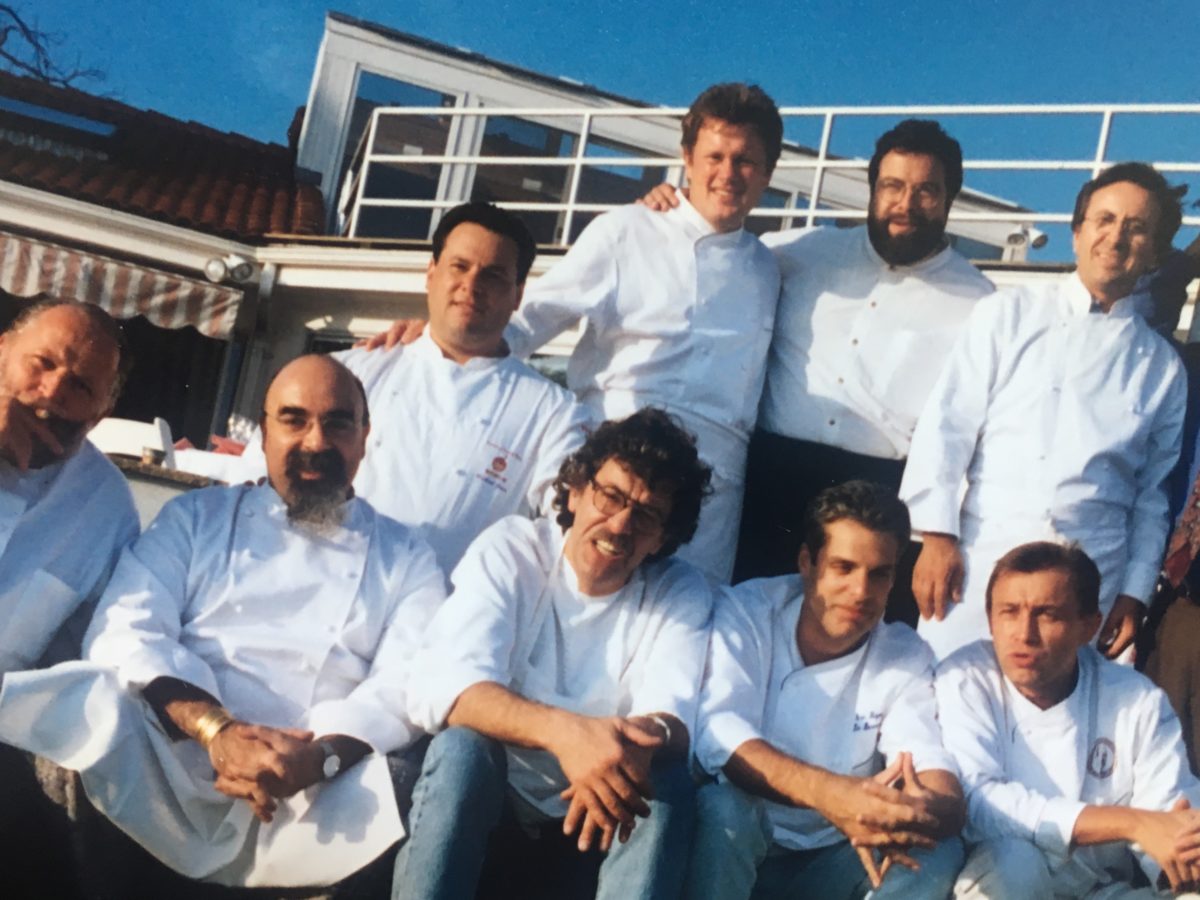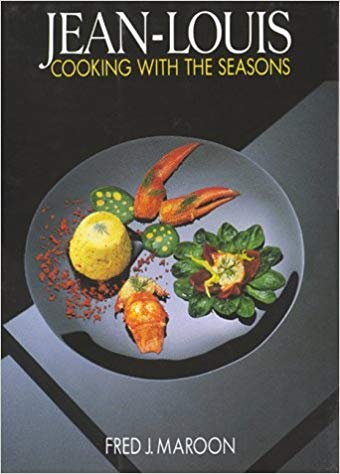[Editor’s Note: We heard from many listeners after our Jean-Louis Palladin tribute on the podcast last week--people who had eaten at the legendary chef’s D.C. restaurant, or worked for alums of his kitchens, or who admired him from afar. Among those who wrote in was our pal Aaron Arizpe, who had–amazingly–been sitting on an unpublished obituary/remembrance of Jean-Louis. We offered to share it here for those of you who knew or remember this great chef, or whose interest was stimulated by last week’s podcast. We are running it as it was originally dated and written. A huge thank-you to Aaron for sharing, and to restaurateur Drew Nieporent for coming through with some photographs from his Smithsonian-worthy iPhone library. – Andrew]

November 25, 2001
Thirteen years ago, he sourced pig bladders in Virginia. He got day-boat scallops from Maine, and his crawfish from Louisiana. His venison came from Texas, soft-shell crabs from Maryland, and all manner of wild mushrooms from Oregon. But Jean-Louis? He was born in France, in Gascony. He arrived in the United States more than twenty years ago but his accent is still as thick as demi-glace, as if all of the words in his brain were written in italics. He has always been a tall, lanky man, bespectacled with a curly mop on his head – a cross between Weird Al Yankovic and a young Geraldo Rivera – but today he looks especially thin, almost gaunt. Today, Jean-Louis is not well.
Mr. Palladin’s mother had been a nurse and his life dream, he says, was to have been a surgeon. Instead he began apprenticing in the kitchen of a local restaurant at the age of twelve. By 22, he had finished culinary school in Toulouse, and internships in Paris and Monte Carlo. That year, he returned home to open a restaurant in a converted 14th Century monastery. In 1974, at the age of just twenty-eight, he became the youngest chef ever awarded two Michelin stars. Not long thereafter, he met his soon-to-be wife, Régine, and they moved together to Washington, D.C. at the behest of a Hungarian ambassador named Nicolas Salgo, who had financed a commercial and residential complex near the meeting place of the Potomac River and Rock Creek.
So it was that, in 1979, Palladin opened Jean-Louis at Watergate. (Yes, that Watergate, whose name will be forever linked to the Nixon scandal seven years prior.) By 1985, he and Régine had two children, a boy named Olivier and a girl named Verveine, French for verbena. In those days, a young cook named Thomas Keller would drive down from New York once every year or so to eat in Jean-Louis’ restaurant. Perennially strapped for cash, he would eat alone and sleep on the cheap, in the Howard Johnson Inn across the street.
Other chefs-in-the-making looked to Palladin for inspiration, guidance, and precisely the kind of tough love you might expect from someone so unflinchingly dedicated to their craft. He helped the sheepish Eric Ripert – the cook he always rode the hardest and whose spirit he’d almost broken – land a job at Le Bernardin in New York, and endorsed Daniel Boulud for the head chef position at Sirio Maccioni’s Le Cirque. He was the “the man everyone looked up to and wanted to be around,” recalls Michael Mina. Michel Richard said he became a chef because of Jean-Louis, and mega-restaurateur Drew Nieporent calls him the “most important influence in [his] life in terms of food.”
LISTEN TO OUR PODCAST TRIBUTE TO JEAN-LOUIS PALLADIN
It wasn’t just Americans who took notice of his cooking. During a time when a certain amount of audacity was required of French émigrés cooking in the United States to champion (or even look for) regional American ingredients, Palladin did exactly that. And so it was that Alain Ducasse came to meet him, at the 2nd annual Masters of Food & Wine in Carmel, CA, in February 1988.

(photo courtesy Drew Nieporent)
Photos from the event depict a jovial crew of chefs and a $2,000 mound of black truffles on a cutting board, chopped dutifully by Mr. Nieporent. It was a bright stage and Jean-Louis was determined to shine. His inspiration was the Lyonnais classic poularde en vessie, in which truffle slices are slid under the skin of a young hen before it is stuffed into a pig’s bladder and poached in stock. Jean-Louis’ twist was to use pigeon in place of the chicken. “I hope I do not hurt any French feelings if I say that I have the best squabs,” he would later write. “And they are American.”
But not only are pig bladders difficult to come by in the United States; they are illegal to sell. So he had tracked some down by the cover of night, somewhere in Virginia, and smuggled them onto the plane. He inflated them with a bicycle pump that he found in a nearby garage. And finally, at Drew’s suggestion, the duo paraded the cooked birds around the dining room in chafing dishes like floating balloons. It was a spectacle met with resounding applause from Mr. Ducasse and the rest of Jean-Louis’ audience, although the pigeons, ironically, were undercooked.

The following year, Palladin worked with photographer Fred J. Maroon on Jean-Louis: Cooking with the Seasons, as much an art book as one meant to be used for cooking. He stayed at the Watergate in D.C. until the restaurant was closed under new management in 1996, by which point Jean-Louis’ attention was already elsewhere. His marriage with Régine had crumbled, and they divorced. (“I knew Jean-Louis for many years,” she would later joke. “I was occasionally his wife.”) He had been on TV a few times – cooking duck breasts in a fireplace with Julia Child, making clam bisque for David Letterman, and later sharing a second segment on the comedian’s late night show with the Dave Matthews Band – but channels like the Food Network were only in their infancy and Palladin wasn’t destined to be that kind of star anyway.
SUBSCRIBE TO OUR (FREE) E-MAIL UPDATES
In 1997, he opened a restaurant in Las Vegas called Napa, and in May of 1999, an eponymous one in New York. “Palladin comes to New York a riddle wrapped in a mystery, trailing a fragrant plume of foie gras and truffles,” wrote William Grimes in a two-star review for the New York Times on June 23, 1999. In spite of the chef’s grand reputation and his signature oxtail crepinette with bone marrow flan – “the greatest meatball known to humanity, a small bomb capable of stunning a vegetarian at 100 paces” – the city never quite warmed to the restaurant. But that didn’t stop the chef from boarding plane after plane to Las Vegas and back in order to run both kitchens, and it certainly didn’t help his two-pack-a-day cigarette habit.
Then on December 12, 2000, during one such trip to Sin City, his doctor called with a grim diagnosis: Jean-Louis had lung cancer. It was on his left lung, dangerously close to his aorta, and it was advanced. “I don’t think I’m sick,” he would tell his friends. “But I know I’m sick.” So earlier this year, Jean-Louis came “home” again, to his ex-wife’s house here in McLean, VA, where friends and admirers from around the world have since come to pay their respects. Because of the cancer, his esophagus was removed and he is unable to eat, so fellow cooks bring him aromatic foods like white truffles just so he can enjoy the smell. Some visitors Régine politely declines, for the chef has shriveled to a sad skeleton of his former self.
Two days ago, Palladin wandered into the kitchen and decided to cook. It was a bittersweet moment, one shared with his ex-wife and his children, but he had lost muscular coordination. Yesterday Alain Ducasse and Michel Richard came by. But Jean-Louis needed to rest, he told Régine, so she took the men to shop at a nearby Asian market. Then the chef decided that he wanted to clarify a broth he had made the day before, and started barking orders at his bewildered sister Monique. “I need to cook!” yelled Jean-Louis, frustrated to tears, when Régine walked back into the house. And so it was that, hours later, the chef, his family, and two of his dearest friends sat solemnly together around the dinner table, barely picking at their food.
Today, Jean-Louis Palladin died at the age of 55. He used to delight in telling people how, when he was 16 years old, he was expelled from culinary school for punching a teacher. Friends believed he might pummel his cancer, too; but he couldn’t. His cookbook contains an anecdote about hunting wood pigeons, something of a ritual in his native Gascony. Some of the flock, hungry and thirsty after their migratory journey, is lured by the siren song of captive birds eating and drinking below. There they are bagged, 300 at a time, in huge nets by human captors. “But there are always a few intelligent ones to stay in the trees,” wrote Palladin. “They are suspicious and somehow know better than to come down.” Wherever he is now, maybe Jean-Louis knows better, too.
– Aaron Arizpe

